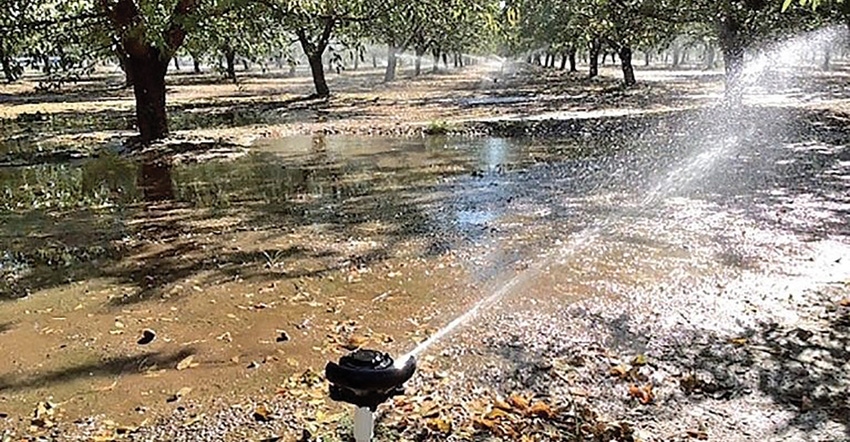
Given this year’s harvest circumstances, it’s almost not a matter of “if,” but a matter of “how much” stress will be endured by almond trees post-harvest.
Researcher David Goldhamer has been focusing on stress in almond trees — how much and of what duration — for years and said, “You’ve got to be blind not to see what’s going on with the drought. Drive by some orchards and look at the shape of the canopies and you’ll see that at least some growers are having extremely serious problems.”
Writing in Irrigation Science magazine in the early 2000s, the UC Davis expert concentrated on the mid-August through end-of-September time frame in San Joaquin Valley’s Kern County and why pre- and post-irrigation on Nonpareils was so important.
“When it came time to post-harvest irrigate the trees, nobody had a clue what to do,” he remembered. “Conventional wisdom back then was that once the nuts were off the tree, not much care was paid relative to irrigation, kind of lolly-gag around and maybe put a little water on between harvest and the end of the year. Nobody gave it much thought.”
Until they did think about it and decided to find out more about post-harvest tree stress and how irrigation played a part.
“The harvest period was by far the most critical stress period in relation to having sustained maximum yields or high-quality fruit,” he discovered. “This was completely opposite of conventional wisdom and the opposite of what we did with normal tree crops like peaches, plums, nectarines, and grapes. Nobody cared what went on after harvest. Turns out the bud development then, the reproductive development, suffered water stress.
“These were the flowers that got turned into fruit the following year, but if the buds got screwed up if they were stressed over those several weeks. They’d flower the following year, but a high percentage of those flowers never evolved into fruit. If you stress those trees during the August-September harvest, you decrease the number of flowers that turn into fruit the following year because these trees are ten times more sensitive to stress --- for every unit of water you deprive those trees, there’s a ten times greater negative impact on yield.”
Almonds extremely late
Flowering times differ among deciduous tree species and for some reason, almonds are extremely late compared to traditional stone fruits. “It’s the only species we know of that’s really sensitive to post-harvest stress. That’s why it’s so critical for growers to know this and in a drought with limited water supplies, hopefully they can save back enough water out of pre-harvest to have some for post-harvest use.”
In current conditions, it’s not a matter of being able to completely avoid water stress, it’s a matter of whether growers have enough control over when they apply the liquid and how much they put on to regulate the stress. “There’s irrigation districts that have shut off water early and growers are out of luck if they don’t have any post-harvest water. Most districts and people who have the ability to pump groundwater are saving some for post-harvest.”
“There are only two real yield components in almonds, the number of nuts per tree and the size of the nut kernel,” Goldhamer said. “We believe that suffering fruit size reduction is preferable to risking serious reductions in fruit load, the number of nuts per tree.”
Almonds in general need some 48 to 50 inches of water in mature orchards and can probably be cut back to 45 or 46 if done judiciously. “Once you get beyond that, there’s going to be a negative impact and that may be one of the reasons why some growers are removing part of their orchards and planting other trees, like pistachios that can survive on much less water.”
Read more about:
AlmondsAbout the Author(s)
You May Also Like




